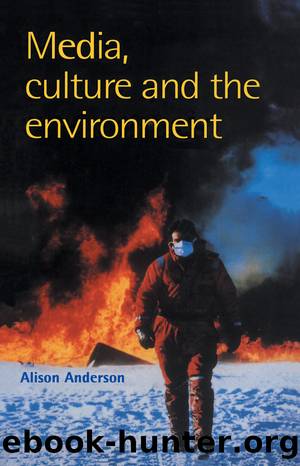Media, Culture And The Environment by unknow

Author:unknow
Language: eng
Format: epub
ISBN: 9781138167445
Barnesnoble:
Publisher: Taylor & Francis
Published: 2017-04-26T00:00:00+00:00
Explanations of story selection
News values
As we saw in Chapter 2, far from news representing a random response to issues and events, it is highly structured by routine organizational practices. Journalists typically operate with a set of unquestioned news values that frame their activity. Although media practitioners work within various guidelines, many values remain implicit. In judging the newsworthiness of particular stories the reporter makes various assumptions about the audience, editorial identity and conventional story telling mechanisms. These values operate at several different levels within the news production process. Bell (1991) divides them into three main categories, though clearly there is some overlap: (1) values in news actors and events; (2) values in the news process; and (3) values in the news text.
An influential news values scheme, developed by Galtung & Ruge (1965), is based upon an analysis of the presentation of three crises in the Scandinavian press. Galtung & Ruge identified eight key factors that shape the news:
Frequency â this refers to the extent to which an item fits the news production cycles of a media organization. Generally, the news media tend to rely upon items that fit into a 24-hour cycle. So unless a gradually developing environmental problem is perceived to have come to a climax, it will often tend to be neglected in favour of the more immediate story. However, as I suggested in Chapter 2, there are important differences between and within the news media.
Amplitude or size â the degree of amplification (or issue threshold) that an event has to reach before being viewed as newsworthy. For example, this might include the number of people who have to be killed by a natural disaster, or the sheer scale of an oil spillage, before it is deemed sufficiently newsworthy to be prominently reported.
Ambiguity â the less ambiguous an event the more it is likely to be covered. Thus issues that can be presented as relatively clear-cut tend to be more newsworthy. An increased recognition of the complexity of environmental issues may have contributed to decreased levels of reporting evident in many Western countries during the early 1990s (Anderson & Gaber 1993).
Meaningfulness â this refers to an itemâs relevance in terms of cultural proximity and its relation to everyday life. Thus there is a tendency for the news media to concentrate upon âcloser to homeâ items with which we have a degree of familiarity, or upon events in far-away places that are perceived to possess a high degree of relevance.
Consonance â the more an issue is compatible with preconceived ideas about a nation or social group, from which the individuals are drawn, the greater its chance of being represented in the news media as a sort of self-fulfilling prophecy. For example, journalists tend to have particular preconceptions about environmental issues, or about demonstrations, and these types of stories tend to be based upon a familiar script (Bell 1991).
Unexpectedness â at the same time, the more rare or sudden the event, the more likely it is to gain novelty value and grab headline attention.
Download
This site does not store any files on its server. We only index and link to content provided by other sites. Please contact the content providers to delete copyright contents if any and email us, we'll remove relevant links or contents immediately.
International Integration of the Brazilian Economy by Elias C. Grivoyannis(91671)
The Radium Girls by Kate Moore(11930)
Turbulence by E. J. Noyes(7942)
Nudge - Improving Decisions about Health, Wealth, and Happiness by Thaler Sunstein(7622)
The Black Swan by Nassim Nicholas Taleb(7016)
Rich Dad Poor Dad by Robert T. Kiyosaki(6413)
Pioneering Portfolio Management by David F. Swensen(6229)
Man-made Catastrophes and Risk Information Concealment by Dmitry Chernov & Didier Sornette(5925)
Zero to One by Peter Thiel(5691)
Secrecy World by Jake Bernstein(4652)
Millionaire: The Philanderer, Gambler, and Duelist Who Invented Modern Finance by Janet Gleeson(4385)
The Age of Surveillance Capitalism by Shoshana Zuboff(4216)
Skin in the Game by Nassim Nicholas Taleb(4165)
Bullshit Jobs by David Graeber(4101)
The Money Culture by Michael Lewis(4082)
Skin in the Game: Hidden Asymmetries in Daily Life by Nassim Nicholas Taleb(3935)
The Dhandho Investor by Mohnish Pabrai(3705)
The Wisdom of Finance by Mihir Desai(3658)
Blockchain Basics by Daniel Drescher(3511)
